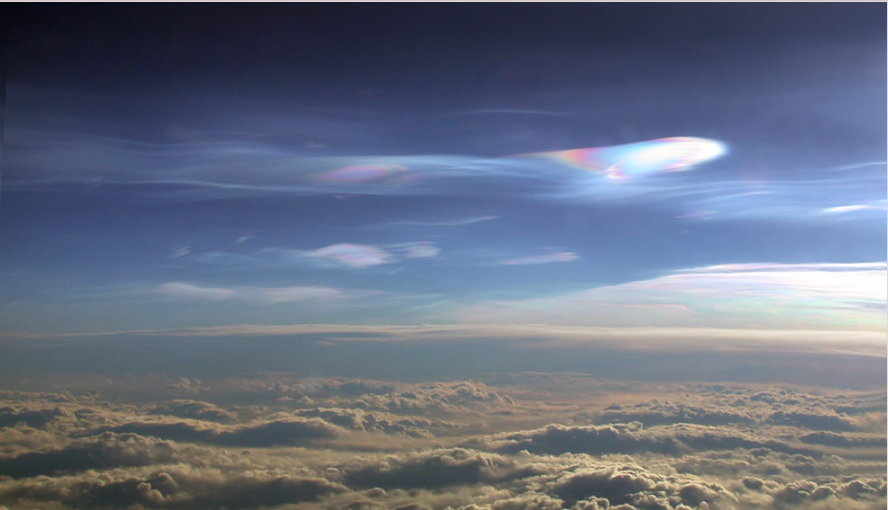Nacreous clouds from high altitude
Nacreous Clouds: A Spectacular Sight from High Altitude
Nacreous clouds, also known as mother-of-pearl clouds, are a mesmerizing atmospheric phenomenon that occurs at high altitudes in the lower stratosphere. These ethereal clouds are a rare sight, captivating observers with their vibrant colors and distinctive wave-like structures. In this article, we will delve into the fascinating world of nacreous clouds, exploring their formation, characteristics, and the scientific insights they provide.
Formation and Composition
Nacreous clouds form in the lower stratosphere, typically between 15 and 25 kilometers above the Earth's surface. These altitudes place them well above the more common tropospheric clouds that we encounter on a daily basis. The unique conditions required for their formation include very cold temperatures, usually below -78 degrees Celsius, and the presence of certain atmospheric particles.
These particles, known as polar stratospheric clouds (PSCs), act as a canvas upon which the nacreous clouds paint their breathtaking display. PSCs consist of tiny ice crystals and supercooled water droplets, which freeze onto pre-existing aerosol particles. The composition of these aerosols varies, but they often include nitric acid and water vapor.
Spectacular Colors
One of the most striking features of nacreous clouds is their vibrant and ever-changing colors. These hues range from iridescent pinks and purples to brilliant oranges and blues. The mesmerizing colors are a result of the sunlight interacting with the tiny ice crystals and aerosols within the clouds.
As sunlight passes through the ice crystals, it undergoes a process called diffraction. This causes the light to scatter in different directions, resulting in the dispersion of various colors. The intricate wave-like structures of the clouds further enhance the diffraction effect, creating a stunning visual spectacle that captivates observers.
Scientific Significance
Beyond their aesthetic appeal, nacreous clouds hold significant scientific value. These unique clouds provide valuable insights into atmospheric dynamics and chemistry. By studying their formation and behavior, scientists can gain a deeper understanding of the complex interactions between various atmospheric components.
Nacreous clouds are closely linked to the occurrence of gravity waves in the lower stratosphere. These waves, generated by disturbances such as wind shear or topographic features, play a crucial role in atmospheric circulation patterns. By observing the wave structures within nacreous clouds, scientists can gather data to improve models and predictions related to weather patterns and climate change.
Observing Nacreous Clouds
Due to their high altitude and specific atmospheric conditions, nacreous clouds are most commonly observed in polar regions during winter months. The extreme cold temperatures prevalent in these regions provide the ideal environment for the formation of these stunning clouds. Antarctica, in particular, offers some of the best opportunities for witnessing nacreous clouds.
To observe nacreous clouds, one must be at a sufficient distance from light pollution and have a clear view of the sky. Patience is key, as these clouds can appear and disappear relatively quickly. Their formation is often associated with stable weather conditions, making it essential to monitor weather forecasts and choose an appropriate location for optimal viewing.
Conclusion
Nacreous clouds are a captivating natural phenomenon that grace the skies at high altitudes. Their vibrant colors and distinctive wave-like structures make them a sight to behold. Beyond their visual allure, these clouds offer valuable scientific insights into atmospheric dynamics and chemistry. By studying nacreous clouds, scientists can enhance their understanding of gravity waves and improve weather and climate models. So, if you find yourself in a polar region during winter, keep your eyes on the sky for the enchanting display of nacreous clouds.

This image from a NASA research aircraft begins to show just how high are nacreous clouds above the everyday ones of our troposphere. Their wave structure is obvious and shows the presence of gravity waves in the lower stratosphere. Taken by scientist Paul A Newman of NASA Goddard Space Flight Center. ©Paul A Newman/NASA, shown with permission.
Note: this article has been automatically converted from the old site and may not appear as intended. You can find the original article here.
Reference Atmospheric Optics
If you use any of the definitions, information, or data presented on Atmospheric Optics, please copy the link or reference below to properly credit us as the reference source. Thank you!
-
<a href="https://atoptics.co.uk/blog/nacreous-clouds-from-high-altitude/">Nacreous clouds from high altitude</a>
-
"Nacreous clouds from high altitude". Atmospheric Optics. Accessed on April 19, 2024. https://atoptics.co.uk/blog/nacreous-clouds-from-high-altitude/.
-
"Nacreous clouds from high altitude". Atmospheric Optics, https://atoptics.co.uk/blog/nacreous-clouds-from-high-altitude/. Accessed 19 April, 2024
-
Nacreous clouds from high altitude. Atmospheric Optics. Retrieved from https://atoptics.co.uk/blog/nacreous-clouds-from-high-altitude/.